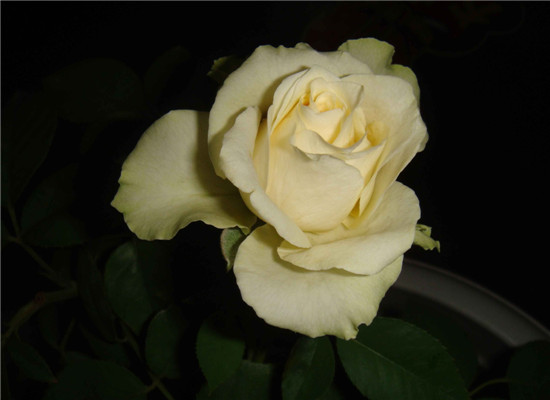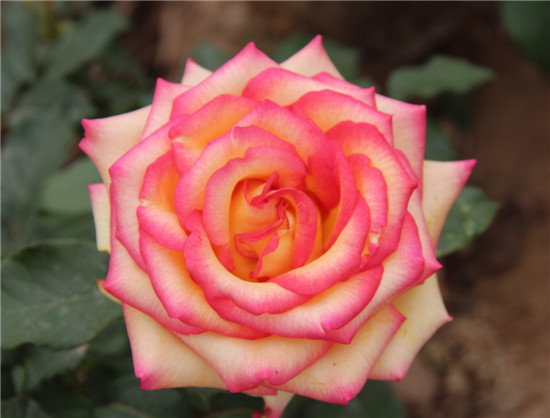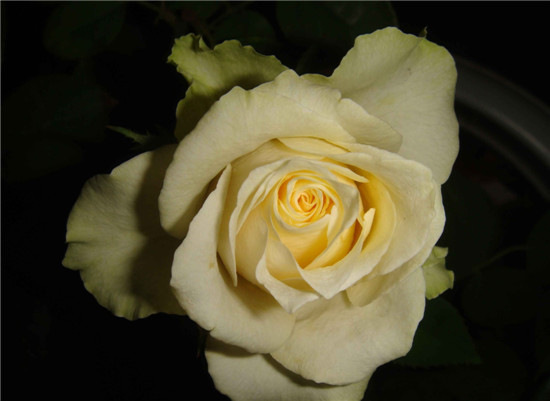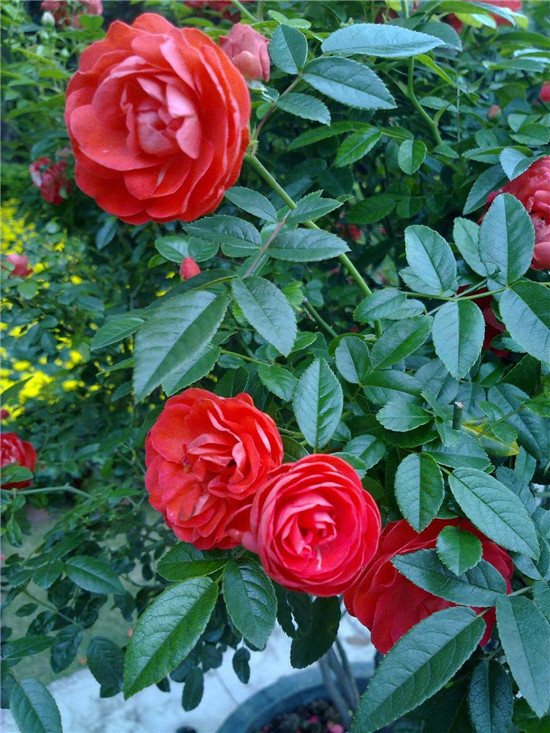Propagation management of cut rose
Cut rose is one of the four largest cut flowers in the world, with more than 8000 varieties cultivated around the world. next, let's take a look at the reproductive management skills of cut rose.

Cut rose is a shrub of the genus Rosaceae. Leaves alternate, odd-pinnate, flat and glossy. Flowers solitary stem apex, flowers double, flower shape, rich color. Like the warm, humid, well-lit environment, the suitable temperature for growth is 15-25 ℃, requiring loose, fertile, well-drained moist soil.
It was propagated by cuttings, grafting and tissue culture. The wild species of Rosa were used as rootstocks for grafting. Before cultivation, the soil should be improved and deep. peat soil and rice bran should be added to make the soil loose and permeable, and sesame sauce residue, bone powder and barnyard manure should be added as base fertilizer. Cut off excess flower buds and lateral branches in time during maintenance.
The temperature control of cut rose cultivated in greenhouse is very important, usually 20-28 ℃ in daytime, so pay attention to ventilation and shading in summer, which not only reduces the temperature, but also reduces the light, and the plant is not susceptible to disease in a transparent environment.
During the growing period, the soil was slightly moist, and the dormant period was reduced to once a week. In order to ensure the quantity and quality of flowers, fertilizer should be applied in time during the growing period, and liquid nitrogen, phosphorus and potassium can be applied. In addition to maintaining the temperature in winter, appropriate supplementary light is also needed.

Temperature management
The most suitable growth and development temperature for cut rose production is 24-26 ℃ in daytime and 14-16 ℃ at night. In winter, when the nighttime was less than 8 ℃, many varieties grew slowly, the branches became shorter and the abnormal flowers increased. When the night temperature was lower than 5 ℃ for a long time, most rose varieties could not send out new branches, or the new branches were shorter and the number of blind branches increased. Therefore, the low temperature in winter seriously affected the branch length, germination and flower bud differentiation of cut flowers, thus affecting the yield and quality; in summer, when the night temperature was higher than 18 ℃ and the day temperature was higher than 28 ℃, the growth and development of most rose varieties were shortened, the number of petals decreased, the flower size became smaller, and the vase life shortened, which had a great effect on the quality of cut flowers; the ideal temperature difference between day and night is 10-12 ℃, which leads to the black edge of petals. In the production practice in central Yunnan, the annual production of high yield and high quality of cut rose can be ensured by controlling the daytime temperature in the greenhouse at 26-28 ℃ in summer and 14-16 ℃ at night in winter.

Soil moisture management
Rose is a crop that likes water but is afraid of waterlogging. Insufficient soil moisture will affect the yield and quality of cut rose; on the contrary, too much soil moisture will cause insufficient root ventilation and affect root development. Therefore, scientific water management must be carried out. Drip irrigation system is suitable for choosing non-polluting river, spring or well water as irrigation water for cut rose. The watering time, watering times and watering amount of cut rose flowers are affected by season, weather, soil and plant growth. Producers are mainly determined according to production experience or instruments, continuous observation, detection of soil water content, plant growth and so on. The instrument can use a soil tensimeter for rapid determination of soil moisture, monitor soil moisture with a tensiometer, and serve as a reference for watering.
Fertilization management
The N:P:K ratio of nitrogen, phosphorus and potassium in the vegetative growth period is 3:1:2, and the flowering stage is 3:1:3. The medium elements and trace elements can be applied regularly every month. The amount of fertilizer application should be considered according to soil fertility, plant growth status and yield, and fertilization methods should be carried out according to facility conditions. In actual production, attention should be paid to the application of organic fertilizer. Soil cultivation needs to add mature organic fertilizer once a year to ensure the need of soil organic fertilizer for cut rose growth. The total amount of organic matter added each year is generally 8-10 tons / mu, in order to supplement the decomposition of organic matter, so that the soil organic matter can reach more than 5%. The best addition time is every autumn and the end of winter. When adding organic fertilizer, dig a shallow ditch 30 cm deep and 25-30 m wide in the middle of the border, then add organic fertilizer directly, and finally mix evenly with the soil.

The cultivation time of cut rose is generally as long as 5 to 8 years, so we should first apply sufficient basic fertilizer, which can be applied to mature livestock manure, nitrogen, phosphorus, potassium fertilizer and so on. The seedlings were planted in the cultivation room with row spacing 45cmx30cm after grafting or cutting. When planting, the roots are scattered in all directions, and the grafting part of the seedlings is buried in the soil 3cm, which is about 2cm higher than the surrounding soil layer. After planting, water was irrigated around the root to strengthen the management of water and fertilizer. The seedlings need more water during the vegetative growth period, and they should be watered once every 2-3 days. Before the axillary buds germinate, the water should be properly controlled, and the amount of water should be gradually increased from the axillary buds to the new shoots to promote the shoot sprouting. From bud formation to flowering stage, it is the peak of water demand in the whole growth period, watering once a day as far as possible. In the first ten days of August and from September to October, middle ploughing and fertilization can be carried out properly, and oil residue, bone powder, chemical fertilizer and plant ash can be applied between plants.
In the early stage of vegetative growth of seedlings, all buds should be removed in time in order to cultivate flowering mother branches and make branches grow healthily. While some varieties sometimes grow 2 or 3 buds on the shoots, it is necessary to retain the main buds in the middle and remove the accessory buds next to them so as not to disperse nutrients and affect the quality of flowering. The buds formed in the hot summer will be affected by high temperature, that is, they bloom poorly and have no commercial value, so they can be seen and picked at this time to promote the development of branches. Rose pruning can be done twice a year, autumn and winter. During the autumn growth period, before the bud is formed, the branches can be re-cut to the height of 60-80cm to renew the old branches, control the flowering period and promote the development of branches. After entering the dormant period to the next year before germination, winter pruning can be carried out to control the plant height and refine the tree type.
These are all the contents of the reproductive management of cut rose that I have summarized for you. I hope this article can help you. Please continue to follow us.
It is about 2cm higher than the surrounding soil. After planting, water was irrigated around the root to strengthen the management of water and fertilizer. The seedlings need more water during the vegetative growth period, and they should be watered once every 2-3 days. Before the axillary buds germinate, the water should be properly controlled, and the amount of water should be gradually increased from the axillary buds to the new shoots to promote the shoot sprouting. From bud formation to flowering stage, it is the peak of water demand in the whole growth period, watering once a day as far as possible. In the first ten days of August and from September to October, middle ploughing and fertilization can be carried out properly, and oil residue, bone powder, chemical fertilizer and plant ash can be applied between plants.
In the early stage of vegetative growth of seedlings, all buds should be removed in time in order to cultivate flowering mother branches and make branches grow healthily. While some varieties sometimes grow 2 or 3 buds on the shoots, it is necessary to retain the main buds in the middle and remove the accessory buds next to them so as not to disperse nutrients and affect the quality of flowering. The buds formed in the hot summer will be affected by high temperature, that is, they bloom poorly and have no commercial value, so they can be seen and picked at this time to promote the development of branches. Rose pruning can be done twice a year, autumn and winter. During the autumn growth period, before the bud is formed, the branches can be re-cut to the height of 60-80cm to renew the old branches, control the flowering period and promote the development of branches. After entering the dormant period to the next year before germination, winter pruning can be carried out to control the plant height and refine the tree type.
These are all the contents of the reproductive management of cut rose that I have summarized for you. I hope this article can help you. Please continue to follow us.
Related
- Wuhan Hospital Iron Tree Blooming Result Was Instantly Frightened by the Gardener Master
- Which variety of camellia is the most fragrant and best? Which one do you like best?
- What is the small blue coat, the breeding methods and matters needing attention of the succulent plant
- Dormancy time and maintenance management of succulent plants during dormancy
- Minas succulent how to raise, Minas succulent plant pictures
- What are the varieties of winter succulent plants
- How to raise succulent plants in twelve rolls? let's take a look at some experience of breeding twelve rolls.
- Attention should be paid to water control for succulent plants during dormant period (winter and summer)
- Watering experience of twelve rolls of succulent plants
- Techniques for fertilizing succulent plants. An article will let you know how to fertilize succulent plants.



